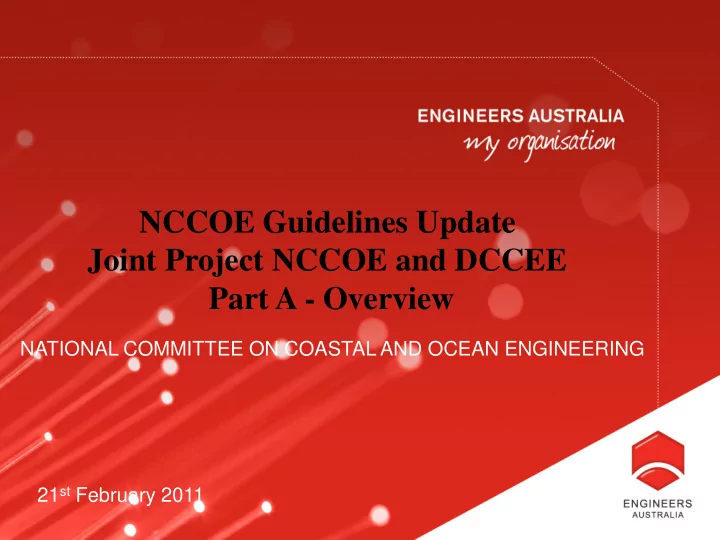

NCCOE Guidelines Update Joint Project NCCOE and DCCEE Part A - Overview NATIONAL COMMITTEE ON COASTAL AND OCEAN ENGINEERING 21 st February 2011
National Committee on Coastal and Ocean Engineering (NCCOE) • Formed in 1971 as a Group within the Civil College • An honorary group of specialist engineering professionals, whose objective is to advance the science and art of coastal and ocean engineering throughout the general engineering profession and the community, by such means as: – facilitating initial and continuing education in our field – assisting in relevant tertiary course accreditation – encouraging and setting priorities for research – ensuring the availability of technical standards – encouraging good coastal and ocean engineering practice – providing a forum and a network for the exchange of views and experience – formulating policy for Engineers Australia in the coastal and ocean area – fostering interaction between the profession and the public on technical and social issues
Basis of the Project • Overseen by Engineers Australia’s National Committee on Coastal and Ocean Engineering • Funding assistance by Department of Climate Change and Energy Efficiency to augment the substantial voluntary input from the profession. • Total Funding available $250,000 to be matched by in kind contribution from EA. • All materials produced under the project would be made available free of charge in hardcopy and electronic format.
Updating of NCCOE Publications • Stage 1 Climate Change Guidelines Upgrade existing Climate Change Guidelines. Presentation to C2C on project in August 2010 Work completed late 2010 with publication currently being organised.
Climate Change Guidelines • Core methodology arose from a workshop of more than 20 professional engineers (peer based) • First published in 1991 in response to the FAR (IPCC 1990) • 2004 Update after the TAR, $30 via EA Books or free via download • Current revision incorporates information to 2010 after AR4
Climate Change Guidelines
Climate Change Guidelines • Aspirations – Factual – Objective – Informative – Up to date – Useful – Widely applied • “One - stop shop” for coastal and ocean engineers • Not to be used by others as a substitute for professional advice and judgement • Represents the start of a process rather than an end
Engineering Impact Assessment 100 Probability of Encountering Events 90 Probability of at Least One Event (%) 10 Yr 80 50 Yr 70 100 Yr 60 200 Yr 50 500 Yr 40 1000 Yr 30 20 10 5 0 1 10 50 100 1000 Exposure Time Considered (yr)
State Responses to Sea Level Rise Jurisdiction 2050 2100 Comment/basis Commonwealth 1.1 High value, adopted for national vulnerability assessment, based on AIF1 emissions scenario New South Wales 0.40 0.90 Benchmark levels, Sea Level Rise Policy Statement October 2009 (http://www.environment.nsw.gov.au/climateChange/sealevel.htm) Victoria 0.8 Victorian Coastal Strategy 2008. “A policy of planning for sea level rise of not less than 0.8m by 2100 should be implemented”. Tasmania - - Sea Level Rise planning benchmarks are under consideration and development of policy in this area is a priority for 2011. South Australia 0.3 1.0 Policy on coast protection and new coastal development 1991 (http://www.environment.sa.gov.au/coasts/pdfs/cpb_policy_1991.pdf) 0.9m for a 100 year period (2010-2110) based on upper bound (95 th percentile) of the IPCC AR4 Western Australia - - SRES scenario A1FI including the allowance for 'scaled-up ice sheet discharge' Northern Territory - - The Storm Tide Inundation Levels for 2050 and 2100 incorporating sea level rise and climate change impacts on cyclone, wind etc have been estimated and storm tide inundation maps are being developed for government approval in the new year. In the absence of any NT Government Policy on sea level rise, the maximum expected sea level rise of 0.3m in 2050 and 0.8m in 2100 has been adopted in the study based on the values adopted by Queensland Government (2009) and Engineers Australia (NCCOE 2004). Queensland 0.3 - 0.3m by 2050 used to direct decisions under existing State Coastal Management Plan (2001). Draft Queensland Coastal Plan proposes to direct use of 0.8m by 2100 for future land use planning decision making; however yet to be adopted as Government policy ( http://www.derm.qld.gov.au/coastalplan/pdf/policy_coastal_protection.pdf )
Climate Change Guidelines • The Guidelines provide an objective framework for rational risk assessment and for developing effective solutions • We emphasise that even with climate trends, climate variability remains a major challenge – Ongoing needs for better data, knowledge and education – Risk methodologies must become more sophisticated – Probabilistic models are needed and must demonstrate skill
Climate Change Guidelines • Climate-change impacts need to be addressed in all coastal and ocean related activities – Sea level rise will modify many coastal environments – Major storm peak intensity may increase – Subtle changes in direction, frequency or intensity of climate forcing may cause significant long term changes in some areas – Coastal population will increase
Updating of NCCOE Publications • Stage 2 - Sustainability Guidelines Sustainability Guidelines to be revised 2010/11 financial year. Work to be largely completed by June and presented at Coast to Coast in Perth, 2011 Publication of Guidelines proposed for early 2011/12.
Updating of NCCOE Publications • Stage 3 – Adaptation Guidelines Guidelines/tools to address adaptation strategies for coastal development. Documentation to be specifically targeted to local level/government (consulting and council engineers, coastal managers and planners). To be illustrated with practical examples, clearly demonstrating available options, advantages and disadvantages.
Recommend
More recommend